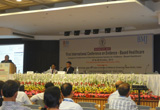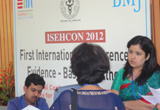 A child with rickets who has received varied, sporadic treatment over two years presents with the inability to walk and a short stature. A 55 year old widow diagnosed with hypertension meticulously preserves prescriptions from follow-up visits to the clinic, fully aware that she will purchase these medicines only when she has a good harvest. A middle–aged woman on anti-epileptics reports to the emergency department with a break-through seizure. These were in no way one-off encounters during my clinical rounds at a rural hospital; rather this was the norm. As doctors we could conveniently label these “cases” as those of “non-compliance” or due to “irregular treatment.” The problem lay with them, not us.
A child with rickets who has received varied, sporadic treatment over two years presents with the inability to walk and a short stature. A 55 year old widow diagnosed with hypertension meticulously preserves prescriptions from follow-up visits to the clinic, fully aware that she will purchase these medicines only when she has a good harvest. A middle–aged woman on anti-epileptics reports to the emergency department with a break-through seizure. These were in no way one-off encounters during my clinical rounds at a rural hospital; rather this was the norm. As doctors we could conveniently label these “cases” as those of “non-compliance” or due to “irregular treatment.” The problem lay with them, not us.
 I was beginning to believe the intricate processes and systems associated with evidence-based medicine [EBM] are for high-resource settings in faraway USA, Europe, and Australia. This was until I attended ISEHCON 2012 in Delhi, where Tony Dans, professor of Internal Medicine at Philippines General Hospital introduced the concept of “assisted non-compliance,” which took me back to these patients. I watched amazed as he struck off 6 drugs out of 10 from a 50 year old diabetic/hypertensive woman’s prescription, bringing the cost of medicines down from $11/day to about $3/day. Based on evidence of efficacy and cost-vigilance, he could eliminate ineffective drugs and prioritize the effective ones. Of course it may sometimes require coming down to that “one drug” your patient must take, or changing the recommended dosage schedule to suit your patient’s preferences. This is still better than the patient making an ill-informed decision to stop all medicines except inconsequential vitamins. As Dans amply demonstrated, poverty could not be an excuse; rather it is the very reason to practice EBM.
I was beginning to believe the intricate processes and systems associated with evidence-based medicine [EBM] are for high-resource settings in faraway USA, Europe, and Australia. This was until I attended ISEHCON 2012 in Delhi, where Tony Dans, professor of Internal Medicine at Philippines General Hospital introduced the concept of “assisted non-compliance,” which took me back to these patients. I watched amazed as he struck off 6 drugs out of 10 from a 50 year old diabetic/hypertensive woman’s prescription, bringing the cost of medicines down from $11/day to about $3/day. Based on evidence of efficacy and cost-vigilance, he could eliminate ineffective drugs and prioritize the effective ones. Of course it may sometimes require coming down to that “one drug” your patient must take, or changing the recommended dosage schedule to suit your patient’s preferences. This is still better than the patient making an ill-informed decision to stop all medicines except inconsequential vitamins. As Dans amply demonstrated, poverty could not be an excuse; rather it is the very reason to practice EBM.
In animated style Victor Montori invoked the audience to “dance with the patient” in making shared decisions about their care and my mind turned to maths. At the same rural hospital, on average 400 patients would be seen by 5 doctors in 4 hours of outpatient clinic, which is an average of 3 min/patient. Where’s the time to think of dancing?! However, as doctors we tend to forget that the most effective medicine is the one that your patient takes. As demonstrated through endeavours in EBM by speakers from across the world, systemic changes are possible: better work allocation, time management, utilization of para-professionals, integration of EBM into training through journal clubs, morbidity/mortality meetings etc. What is needed is the commitment to ultimately do the best for your patient.
As Montori reiterated, evidence alone is never sufficient; consideration of the context and patient’s values, preferences and goals are very central to the process. We could read up all the science on it, but we would need to go that extra step to ensure that the treatment is followed. Is it worth it? Saving the child from a life of confinement and maybe even ridicule; preventing paralysis in the widow whose livelihood depends on working in the fields; avoiding the harrowing experience of a seizure for your patient?
Anita Jain is the India editor, BMJ.